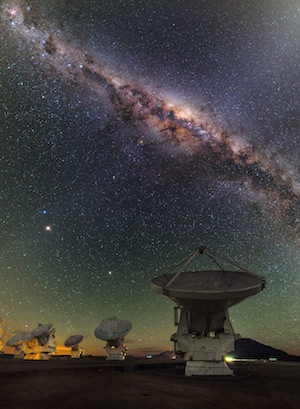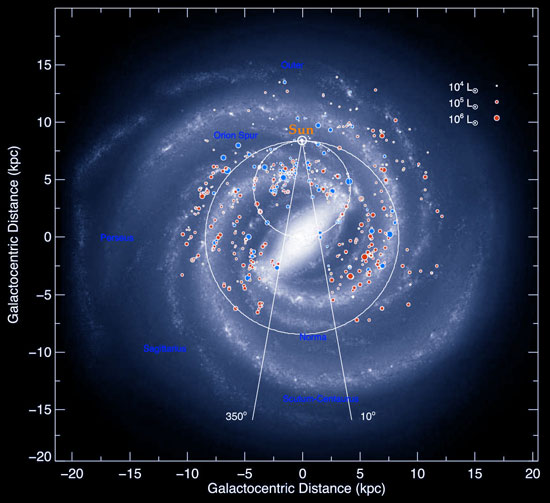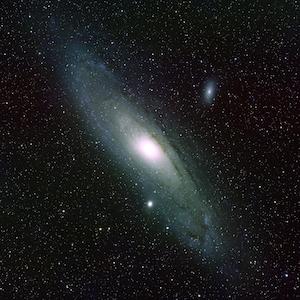The Milky Way Galaxy

Our Sun (a star) and all the planets around it are part of a galaxy known as the Milky Way Galaxy. A galaxy is a large group of stars, gas, and dust bound together by gravity. They come in a variety of shapes and sizes. The Milky Way is a large barred spiral galaxy. All the stars we see in the night sky are in our own Milky Way Galaxy. Our galaxy is called the Milky Way because it appears as a milky band of light in the sky when you see it in a really dark area.
It is very difficult to count the number of stars in the Milky Way from our position inside the galaxy. Our best estimates tell us that the Milky Way is made up of approximately 100 billion stars. These stars form a large disk whose diameter is about 100,000 light years. Our Solar System is about 25,000 light years away from the center of our galaxy – we live in the suburbs of our galaxy. Just as the Earth goes around the Sun, the Sun goes around the center of the Milky Way. It takes 250 million years for our Sun and the solar system to go all the way around the center of the Milky Way.
We can only take pictures of the Milky Way from inside the galaxy, which means we don't have an image of the Milky Way as a whole. Why do we think it is a barred spiral galaxy, then? There are several clues.
The first clue to the shape of the Milky Way comes from the bright band of stars that stretches across the sky (and, as mentioned above, is how the Milky Way got its name). This band of stars can be seen with the naked eye in places with dark night skies. That band comes from seeing the disk of stars that forms the Milky Way from inside the disk, and tells us that our galaxy is basically flat.
Several different telescopes, both on the ground and in space, have taken images of the disk of the Milky Way by taking a series of pictures in different directions – a bit like taking a panoramic picture with your camera or phone. The concentration of stars in a band adds to the evidence that the Milky Way is a spiral galaxy. If we lived in an elliptical galaxy, we would see the stars of our galaxy spread out all around the sky, not in a single band.

Another clue comes when astronomers map young, bright stars and clouds of ionized hydrogen in the Milky Way's disk. These clouds, called HII regions, are ionized by young, hot stars and are basically free protons and electrons. These are both important marker of spiral arms in other spiral galaxies we see, so mapping them in our own galaxy can give a clue about the spiral nature of the Milky Way. There are bright enough that we can see them through the disk of our galaxy, except where the region at the center of our galaxy gets in the way.
There has been some debate over the years as to whether the Milky Way has two spiral arms or four. The latest data shows that it has four arms, as shown in the artist's illustration below.

Additional clues to the spiral nature of the Milky Way come from a variety of other properties. Astronomers measure the amount of dust in the Milky Way and the dominant colors of the light we see, and they match those we find in other typical spiral galaxies. All of this adds up to give us a picture of the Milky Way, even though we can't get outside to see the whole thing.
There are billions of other galaxies in the Universe. Only three galaxies outside our own Milky Way Galaxy can be seen without a telescope, and appear as fuzzy patches in the sky with the naked eye. The closest galaxies that we can see without a telescope are the Large and Small Magellanic Clouds. These satellite galaxies of the Milky Way can be seen from the southern hemisphere. Even they are about 160,000 light years from us. The Andromeda Galaxy is a larger galaxy that can be seen from the northern hemisphere (with good eyesight and a very dark sky). It is about 2.5 million light years away from us, but its getting closer, and researchers predict that in about 4 billion years it will collide with the Milky Way. , i.e., it takes light 2.5 million years to reach us from one of our "nearby" galaxies. The other galaxies are even further away from us and can only be seen through telescopes.

Updated: December 2015


